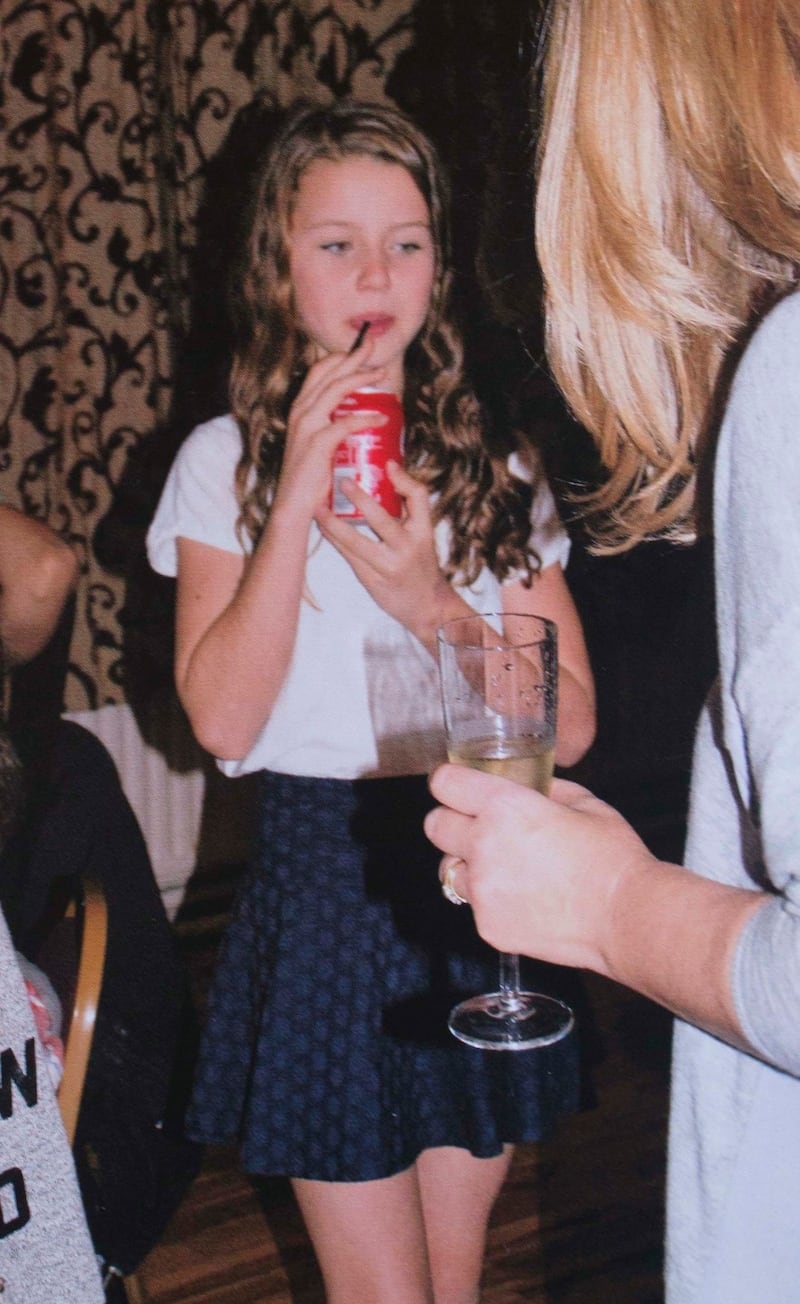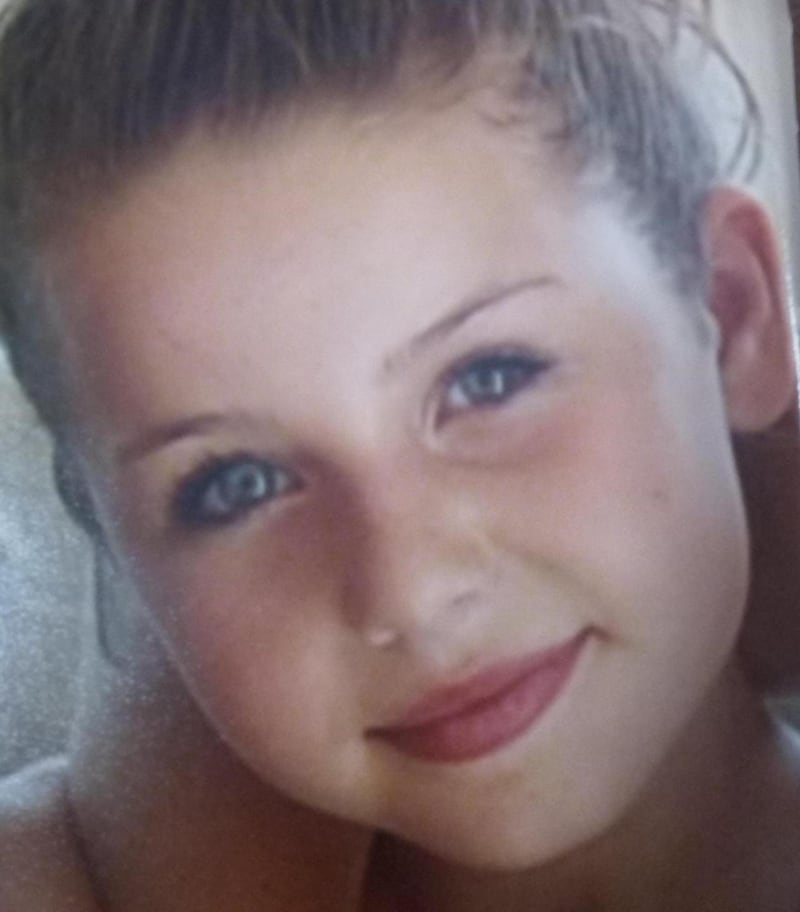The taxi driver dropping me off to a house in south Dublin during Christmas week inquires if I am going to a party: that he has already brought several people to Christmas lunches and parties that day.
He’s just making conversation, but as I stand at Fiona and Tim Tuomey’s front door, I realise that there must be numerous times every day when their world is starkly divided into the people who know their 11-year-old daughter died by suicide and those who don’t.
When Tim opens the door, the family dog, a black spaniel called Wendy, comes bounding out to greet me. There are Christmas cards in the hall and a lovely smell of some kind of aromatic curry coming from the kitchen. It’s a perfectly normal family home and yet it’s a fact that in perfectly normal family homes in Ireland, children as young as Milly can die by suicide.
“It’s hard to encapsulate your daughter in a few sentences, but Milly was funny, she was mischievous, and she was very kind; surprisingly kind for a child,” Tim says, when we are all sitting together in the living room. He tells a story about Milly being upset to see homeless people outside the Gaiety when they had gone to a panto there. “She was crying, and she asked me for some money so she could go back and give it to them.”
“Milly was quite self-critical,” Fiona says. “She was very pretty, but as is often the case, that didn’t matter because she was always comparing herself to others. She was body-conscious.”
On December 8th Fiona found a notebook under Milly's bed filled with drawings and notes on various suicide methods
The country was collectively shocked, disturbed and distressed earlier this month, when the inquest into the death of Milly Tuomey became national news. In November 2015 she posted on social media of her desire to die on a certain day. She expressed suicidal ideation several times after that.
Horrified, scared and unsupported, the Tuomeys started a desperate quest to get her seen by the HSE’s Child and Adolescent Mental Health Services for a clinical assessment, so she could get the help she clearly needed.
At the end of November an appointment was made for her for January 30th. On December 8th Fiona found a notebook under Milly’s bed filled with drawings and notes on various suicide methods, to which she alerted both Milly’s GP and the art therapist Milly had begun to see.
The Tuomeys had tried to get her seen by a clinical psychologist at a private facility, An Cuan, recommended to them by their GP, but had then discovered that the psychologist’s client list was closed. The Tuomeys were told the next available person for Milly to see was an art therapist.
On December 17th, Milly’s appointment with the HSE mental health service was brought forward to January 5th. On New Year’s Day, she left the living room while other family members were watching a movie. Some time later, her older sister Daisy also left the room, and found her sister.
Milly died on January 4th, 2016.
Thick as thieves
There were just 16 months between the sisters, and they had been exceptionally close all their lives. “Those two were as thick as thieves,” says Tim. “They could be on a long car journey of five hours, and they would yap all the way.
One of the most difficult things now is the silence in the house. Milly and her sister were always singing and talking and making noise.”
The Tuomey’s world imploded in early November 2015, when Daisy alerted Fiona to an Instagram post Milly had put up that day. The message was written with the random grammar and spelling mistakes of a child, which made the words all the more horrifying: “You know ive schedueld A date for the day i die…the 23 of december.”

Their journey through the health services began two days later, with an appointment at the GP. Fiona took her and stayed in the room while she was being seen.
“I just said, ‘Milly wants to talk to you about some feelings she has been having.’ And Milly essentially said, very casually, ‘Sometimes I think I’d like to die.’ And he took her through, we all have these feelings sometimes, and they pass, and had anything happened, was she being bullied . She just shrugged her shoulders, but to me, it was the fact that she was so calm during that appointment. That was the most frightening thing. I was terrified. I knew this was something. This was not nothing. This was not looking for attention.”
The GP told Fiona they had two options – talking therapy or the HSE’s child mental health services – and that he recommended starting with talking therapy. Milly began her weekly art therapy sessions on November 24th. “That night, Milly self-harmed,” Fiona says. “She had cut her arms and her legs with a scissors.”
Less than a fortnight later, Fiona found the notebook under Milly’s bed. “It was horrifying,” she says, unconsciously clutching at Wendy, who is snoring on her back beside them on the sofa.
Fiona texted the therapist. “We had an appointment with the therapist the next day, and I was absolutely terrified. We were scared enough beforehand, and I said, ‘How do we address this?’ And she said, ‘We’ll address it together. We’ll talk to Milly and see if she understands that dead means dead. That you can’t come back from this.’ She then said, ‘We’ll try and get the referral speeded up’.”
Fiona and Tim try to explain what they were feeling at that time, when they were simultaneously baffled and terrified at behaviour they could not understand in their beloved daughter.
“She was still doing everything, going to school, doing her homework,” Tim says. “So you’re stuck wondering, is this really, really serious, or is this something that is going to go away because she is functioning perfectly normally?”
The appointment they finally received with the HSE mental health service was brought forward from January 30th to the 5th. Milly was aware of the referral.
“I had said to her that I didn’t want her to ever do anything to harm herself, and that she was never to leave me,” says Fiona. “I said, ‘If you died, I’d cry every day, and I’d never get over it.’ And she said, ‘But you’ve got Daisy’.”
Both parents have been heroically composed until this point, but now they start crying. “What do you say when a child says that to you?”
A series of islands
There is a reason the Tuomeys are reliving all this ghastly pain by giving an interview, or, as Tim puts it, “a moral obligation”. Milly’s death is already in the public domain. They want to focus attention on what they see as the creation of an essential public service, the establishment of a suicide prevention authority.
“From the time Milly died, I engaged in trying to understand more about suicide prevention,” Fiona says. “Ten times more money is spent on road safety than on suicide prevention, and yet three times more people – that we know of – die by suicide every year than on the roads.
"I truly and honestly believe if there is not a suicide authority set up in the same vein as the Road Safety Authority, there is absolutely no chance of the entire structure of suicide prevention being ringfenced to prevent something like this happening. At the moment, it is a series of islands that you have to navigate between."

Tim says: “The child angle on this is very important. A lot of the shock and upset and support we have had for our daughter is based on how young she was. Our fear is that if things don’t change, she’s not going to be an exception; she is going to be the norm, because the age is coming down and down. When it comes to kids, maybe people aren’t moving fast enough to realise it is getting younger and younger; that kids are now able to do this suicide ideation with the help of the internet.”
They have since been contacted by “dozens” of parents worried about their own children, or who have also lost very young children, including another 11-year-old, whose “story was kept out of the papers”, Fiona says.
They sincerely hope people will move on from believing that suicide or suicide ideation is a “taboo” subject, and talk openly about any problems or worries they are having, so that others can be helped.
The Daisy Spa
During her last Christmas, Milly, who loved music, received a piano keyboard as her gift. “She adored it,” Fiona says. Milly was quieter than usual, but seemed calm. They went away between Christmas and New Year for a short holiday, and the two sisters took Wendy into their hotel room, and gleefully washed the dog in their bath.
On New Year’s Eve, Milly gave a little concert to her family, with handwritten invitations. The same day, Daisy set up what Fiona calls, “The Daisy Spa” in the family bathroom. “We had to go in individually for treatments,” Fiona says.
When Fiona went in for hers, Daisy told her that she had given Milly a head massage, “And Daisy said after it, ‘How are you feeling now?’ and Milly said she didn’t want to talk about it.”
'All along the stages we needed someone to press the panic button for us'
In Switzerland, where the family lived for five years until 2015, the sisters had shared a large bedroom. “I used to go in in the evening and the two of them would be in the same bed,” Tim says. “They each had their own beds, and I thought they were messing. But every evening they would get into one of their beds together for a while and talk about their day. If they had any concerns, they would tell each other. It was a ritual they had. So in a childlike way, Daisy was saying to Milly in the Spa, are you okay? And Milly wouldn’t speak to her.”
Five days later, on January 4th, Milly died in Our Lady’s Hospital for Sick Children, one day before her appointment with the HSE mental health service.
“All along the stages we needed someone to press the panic button for us,” says Tim. He believes that, as parents, they were “left alone to cope” by the health services.
“Suicide ideation, if addressed in time, it can be prevented,” says Fiona. “For us there was no oversight from beginning to end, no sense of urgency aside from getting the appointment. I find it astounding in 21st-century Ireland that if a child is getting a letter from a GP saying the child has self-harmed, and if it’s been written about in assessment forms, that nobody would want to see them immediately. What does it take to be seen immediately?”
Of Milly’s suicide, Fiona says, “I will never understand it. I have stopped trying to understand it. It’s glaringly obvious to us with 20/20 hindsight that Milly was set adrift, as were we. We’ll never know what Milly had, because we never got an assessment.”
On Thursday, Fiona and Tim Tuomey handed in a petition with 28,000 signatures to Hawkins House, to urge the government to establish a suicide prevention authority. They are still collecting signatures at 3ts.ie.
- If you are affected by any of the issues raised, you can contact:
Childline on 1800-666666 or text "support" to 50101
Pieta House at 1800-247247
Samaritans by telephoning 116123 for free, texting 087-2609090 or emailing jo@samaritans.org









